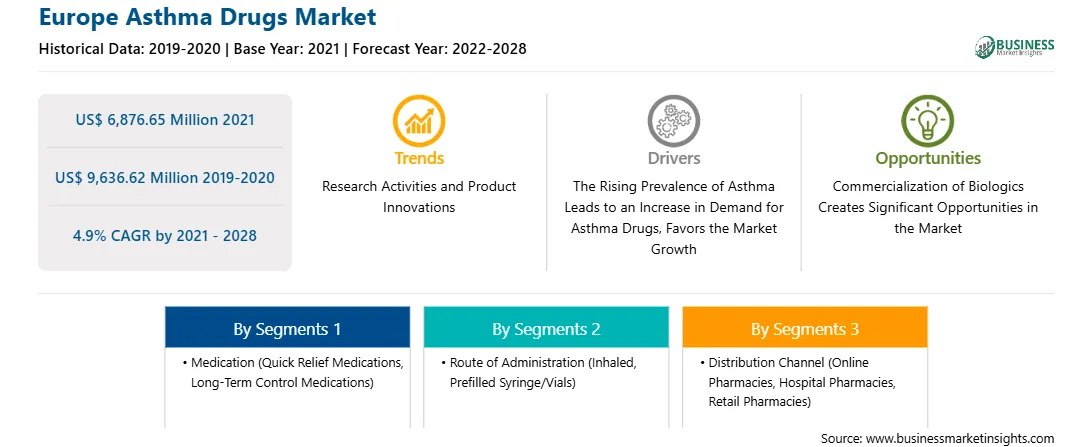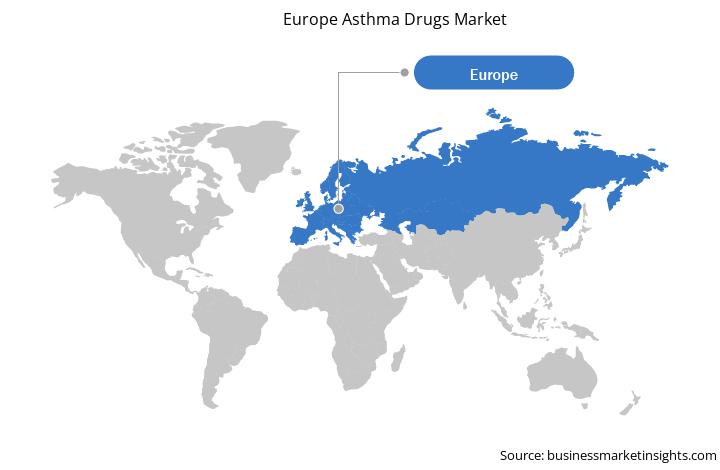The growth of the market is attributed to the rising prevalence of asthma and the growing exposure to coarse particulate matters. However, the unmet medical needs hamper the market growth.
Asthma is a disorder in which psychological elements have played a significant role since the 20th century. Clinicians understand that emotional stress can trigger or exacerbate asthma and that a patient's mental health can impair asthma control by influencing symptom presentation and treatment adherence. As a result, there is a bi-directional link between asthma and psychological issues.
Asthmatics and asthma exacerbations are associated with periods of heightened emotionality. Depressive disorders are more common among people with asthma than in the general population, according to various prevalence estimates, some of which reach 40%. Patients with bipolar affective disorders tend to have a higher chance of acquiring IgE-mediated allergy diseases, such as asthma, than the general population. Anxiety disorders also have an elevated prevalence in asthma, affecting up to one-third of asthmatic children and adolescents and 24% of asthmatic adults.
Ambiguous disease criteria, inconsistencies in nomenclature, limited samples, and an emphasis on outpatient or inpatient population rather than the community affects the research on the frequency of psychological and mental disorders in asthmatics. The World Mental Health Survey addresses a few of these methodological issues by providing standardized data for 17 nations across the world. Compared to individuals without asthma, the pooled estimates of age- and sex-adjusted odds of mental disorders were 1.6 (95% CI=1.4, 1.8) for depressive disorders and 1.5 (95% CI=1.4,1.7) for anxiety disorders. There was also a link between asthma and alcohol use disorders (OR 1.7 (95% CI=1.4, 2.1) in this study.
Although the frequency of mental disorders and asthma varies substantially between nations, there was much less cross-sectional heterogeneity in their connection. Given that the countries represented varied greatly in terms of culture, healthcare organization, and socioeconomic development, this constancy is remarkable. It suggests that practitioners in any environment should be aware of the extensive overlap between asthma and psychological and mental illnesses.
Early psychosomatic models suggested that psychological discomfort played a role in varying asthma morbidity among asthma patients. However, emerging knowledge of pathophysiological pathways indicated that psychological variables might also play a role in the genesis of asthma. The disruption of critical biological systems such as the neuroendocrine stress response, cytokines, and neuropeptides is similar to asthma and serious depressive disorders. Additional evidence of a genetic relationship between atopic and depressed symptoms comes from twin-pair studies.
Because of the link between asthma and psychological issues, psychological therapies are occasionally employed to supplement pharmaceutical asthma care. Behavioral therapies, cognitive therapies, cognitive-behavioral therapies (CBT), relaxation techniques, psycho-dynamic psychotherapies, and counseling (both for the person and the family) have all been tried. Unlike pharmacological asthma treatments, there is still a lack of evidence regarding the effectiveness of psychosocial therapy in children and adults. This is expected to boost the need for asthma treatments in the coming years, driving the European asthma drugs market.
Strategic insights for the Europe Asthma Drugs provides data-driven analysis of the industry landscape, including current trends, key players, and regional nuances. These insights offer actionable recommendations, enabling readers to differentiate themselves from competitors by identifying untapped segments or developing unique value propositions. Leveraging data analytics, these insights help industry players anticipate the market shifts, whether investors, manufacturers, or other stakeholders. A future-oriented perspective is essential, helping stakeholders anticipate market shifts and position themselves for long-term success in this dynamic region. Ultimately, effective strategic insights empower readers to make informed decisions that drive profitability and achieve their business objectives within the market.

| Report Attribute | Details |
|---|---|
| Market size in 2021 | US$ 6,876.65 Million |
| Market Size by 2028 | US$ 9,636.62 Million |
| Global CAGR (2021 - 2028) | 4.9% |
| Historical Data | 2019-2020 |
| Forecast period | 2022-2028 |
| Segments Covered |
By Medication
|
| Regions and Countries Covered | Europe
|
| Market leaders and key company profiles |
The geographic scope of the Europe Asthma Drugs refers to the specific areas in which a business operates and competes. Understanding local distinctions, such as diverse consumer preferences (e.g., demand for specific plug types or battery backup durations), varying economic conditions, and regulatory environments, is crucial for tailoring strategies to specific markets. Businesses can expand their reach by identifying underserved areas or adapting their offerings to meet local demands. A clear market focus allows for more effective resource allocation, targeted marketing campaigns, and better positioning against local competitors, ultimately driving growth in those targeted areas.

Europe Asthma Drugs Market Segmentation
The Europe asthma drugs market, by medication, is segmented into quick relief medications and long-term control medications. Based on route of administration, the market is segmented into inhaled, prefilled syringe/vials, and others. Based on distribution channel, the Europe asthma drugs market is segmented into online pharmacies, hospital pharmacies, and retail pharmacies. By country, the market is segmented into the Germany, Spain, Italy, France, UK and Rest of Europe.
AstraZeneca; TEVA PHARMACEUTICAL INDUSTRIES LTD;
Boehringer Ingelheim International GmbH; GlaxoSmithKline plc.; Merck & Co., Inc.; Koninklijke Philips N.V.; Sanofi;
Pfizer Inc. (Arena Pharmaceutical GmbH); Novartis AG; and Abbott are among the leading companies operating in the Europe asthma drugs market.
The Europe Asthma Drugs Market is valued at US$ 6,876.65 Million in 2021, it is projected to reach US$ 9,636.62 Million by 2028.
As per our report Europe Asthma Drugs Market, the market size is valued at US$ 6,876.65 Million in 2021, projecting it to reach US$ 9,636.62 Million by 2028. This translates to a CAGR of approximately 4.9% during the forecast period.
The Europe Asthma Drugs Market report typically cover these key segments-
The historic period, base year, and forecast period can vary slightly depending on the specific market research report. However, for the Europe Asthma Drugs Market report:
The Europe Asthma Drugs Market is populated by several key players, each contributing to its growth and innovation. Some of the major players include:
The Europe Asthma Drugs Market report is valuable for diverse stakeholders, including:
Essentially, anyone involved in or considering involvement in the Europe Asthma Drugs Market value chain can benefit from the information contained in a comprehensive market report.